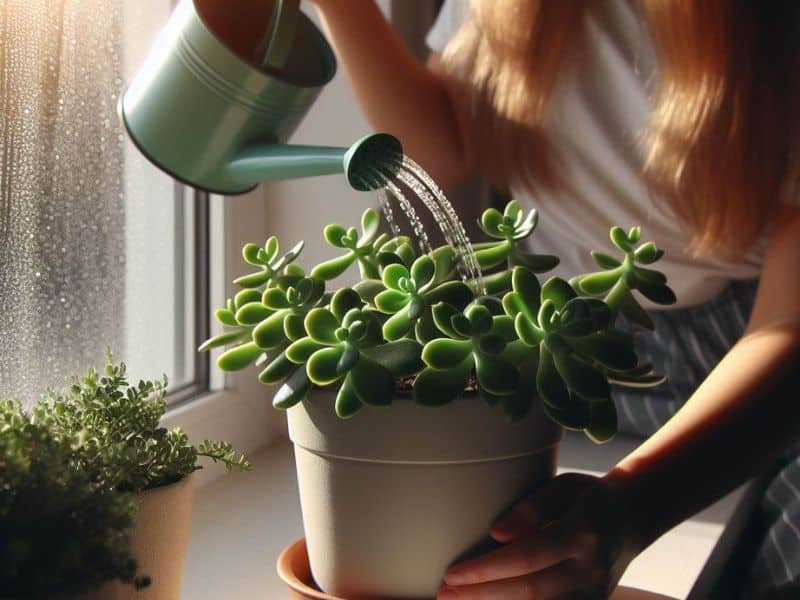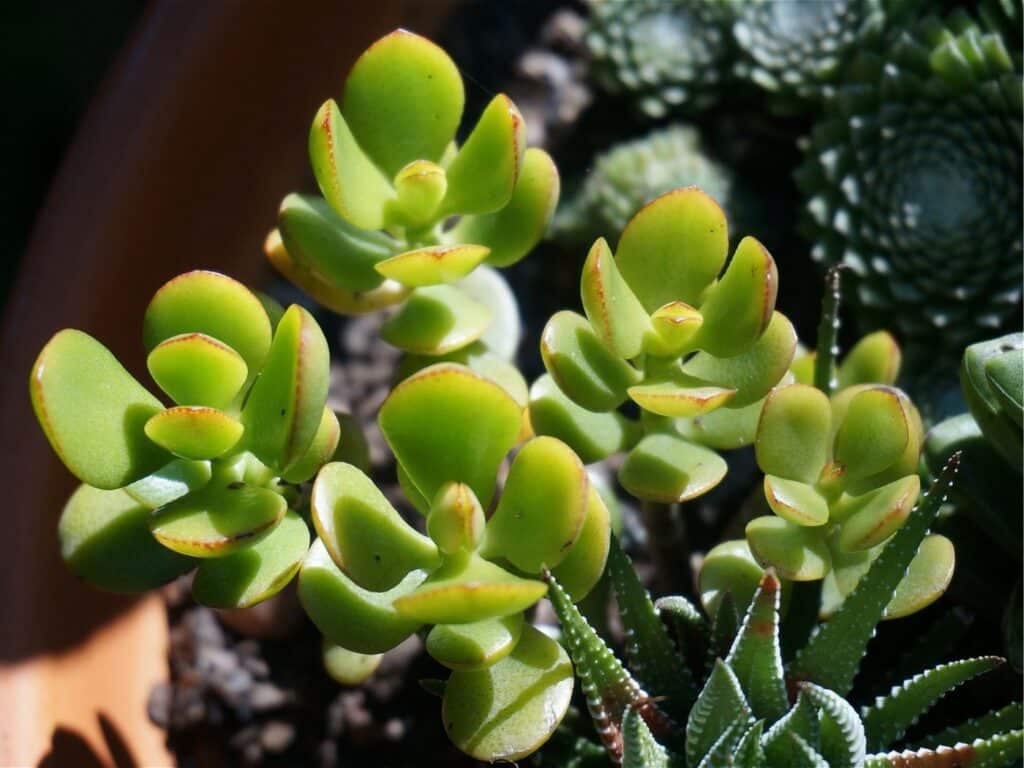Discovering your jade plant with droopy leaves and a less-than-lively appearance can be disheartening, especially when you’ve been diligent with your care routine.
Often, the culprit behind this distressing scene is overwatering, a common mistake even among the most seasoned plant enthusiasts. Overwatering can lead to a host of issues, including root rot and fungal infections, which compromise the health and beauty of your beloved plant.
Understanding the signs of overwatering and knowing how to address them is crucial for any plant owner. This guide is designed to walk you through the steps to identify, treat, and prevent overwatering, ensuring your jade plant not only survives but thrives.
By recognizing the early warnings and implementing the right solutions, you’ll be equipped to restore your jade plant to its former glory and enjoy its beauty for years to come.
Identifying an Overwatered Jade Plant
Signs and Symptoms
Recognizing an overwatered jade plant starts by observing a few key signs. First, the leaves become soft and squishy to the touch, losing their usual firmness. This sponginess is a tell-tale indicator that the plant is retaining more water than it can handle.
Additionally, leaves may well start yellowing or turning a darker shade, signifying stress. Beyond the leaves, check the stem; if it feels mushy or looks discolored, this is a critical sign of overwatering.
Root rot, characterized by black or brown, slimy roots, is another severe symptom, but you’ll need to remove the plant from its pot to inspect the roots directly.
Comparing Healthy and Overwatered Plants
A healthy jade plant stands firm with vibrant green leaves, each one plump but not overly swollen. The leaves exhibit a waxy sheen, indicative of good health, and the stem is sturdy and green.
Contrast this with an overwatered jade plant—its leaves appear swollen, discolored, and may drop off easily. The stem may also show signs of decay, becoming soft and losing its robust structure.
In essence, if your jade plant has gone from perky and green to droopy and sad, overwatering may well be the culprit. By paying close attention to these differences, you can catch overwatering early and take steps to mitigate the damage before it’s too late.
Causes of Overwatering in Jade Plants

Watering Mistakes
Overwatering jade plants often stems from well-intentioned, yet excessive, watering routines. You may well think you’re giving your plant a treat, but too much water is like giving candy to a baby – good in moderation, but too much leads to problems. The common mistake is not waiting for the soil to dry out completely between watering sessions.
Unlike other plants that enjoy consistent moisture, jade plants need their soil to go completely dry before you reach for that watering can again. Ignoring this can lead to waterlogged soil, creating an environment where root rot thrives.
Environmental Factors
In addition to overzealous watering habits, environmental conditions play a critical role in the overwatering of jade plants. Poor drainage is a major culprit.
If your pot doesn’t allow excess water to escape, it’s like your plant’s roots are sitting in a mini sauna – except this kind of heat doesn’t lead to relaxation. It’s crucial to ensure your jade plant resides in a pot with adequate drainage holes.
Also, consider the humidity and temperature of your plant’s environment. High humidity and cooler temperatures can slow down the evaporation of water, adding to overwatering woes. Adjusting your watering schedule according to these conditions can prevent your jade plant from suffering from too much of a good thing.
Consequences of Overwatering
Root Rot and Its Impacts
Root rot hits an overwatered jade plant hard, turning what should be a thriving, green spectacle into a struggling mess. As the name hints, root rot affects the roots first, causing them to become mushy and brown as they fail to absorb nutrients and water efficiently.
This condition not only stunts the plant’s growth but can also lead to its untimely demise if not addressed swiftly. Essentially, you’re looking at the plant equivalent of having its foundation crumble—without healthy roots, your jade plant’s days are numbered.
Foliage Damage
Overwatering doesn’t stop its mischief at the roots; it wreaks havoc above ground too. Initially, leaves may seem fuller, misguiding you to believe all is well. However, this lush appearance quickly turns to one of decay, with leaves turning yellow, becoming soft, and eventually dropping off.
It’s the plant’s way of saying it’s had more than its fill of water. In severe cases, stem rot can set in, further compromising the plant’s structure and health. This chain of undue stress diminishes the jade plant’s resilience, making it susceptible to diseases and pests it would normally fend off with ease.
Saving an Overwatered Jade Plant
Adjusting Watering Habits
Quick to react, aren’t you? Well, the first step in reviving your overwatered jade is to dial back on the enthusiasm for watering. These succulents prefer a drought over a flood.
Let the soil completely dry out between waterings. And remember, when you do water, think of it as making a strong coffee – necessary and in moderation. This approach will give your plant’s roots a breather and a chance to recover.
Providing Proper Drainage
If your jade’s potting mix stays soggy for days, it’s time for an intervention. Swap out that dense, water-retaining soil for a mix with perlite, sand, or gravel – think of it as giving your plant some comfy, breathable sneakers instead of tight, suffocating boots.
And don’t forget the pot itself; holes at the bottom are a must. This not only ensures excess water has an escape route but also helps in preventing root rot. A happy plant equals a happy you.
When to Repot
Speaking of pots, size does matter, but bigger isn’t always better for your jade plant. If your plant seems to be drowning in its current container, consider downsizing. A snug pot encourages the soil to dry out faster, reducing the risk of waterlogged roots.
But if the roots are already singing the blues with rot, it’s time to gently remove the plant, trim the damaged parts, and introduce it to a new, well-draining home. Treat it like a patient in recovery: with gentle hands and a hopeful heart.
Preventive Measures for Jade Plant Care
Taking care of a jade plant requires understanding its specific needs, especially when it comes to water. Following the previous discussion on the signs and causes of overwatering, let’s dive into how you can prevent such issues.
Understanding Jade Plant Water Needs
Jade plants thrive in conditions that mimic their natural, arid habitats. They prefer their soil to be dry between waterings. Think of it like a camel storing water for long journeys across the desert – your jade plant does something similar.
It stores water in its leaves, which is why it doesn’t need a drink as often as you may well think. A good rule of thumb is to check the top 2 inches of soil; if it’s dry, it’s time to water. If not, hold off and check again in a few days.
Monitoring and Adjusting Watering Schedules
Your jade plant isn’t the biggest fan of a strict watering schedule. Instead, it appreciates a bit of flexibility. Seasons play a big role in this.
During the warmer months, jade plants may well need more frequent waterings as they grow. Contrastingly, in winter, they enter a dormancy period and require considerably less water.
A practical tip is to mark your calendar whenever you water your plant, starting a rough watering log. This log helps you adjust your watering frequency based on the plant’s growth cycle and seasonal changes. Remember, less is often more when it comes to watering these succulents.
Selecting the Right Soil and Pot
Choosing the right soil and pot for your jade plant is akin to picking the best running shoes for a marathon; it can make all the difference.
For soil, aim for a mix that promotes excellent drainage – a succulent or cactus mix works perfectly. These mixes often contain sand or perlite, improving air flow and reducing water retention. Now, about the pot, make sure it has sufficient drainage holes.
A pot that holds water is a no-go. Terracotta pots are a solid choice because they absorb excess moisture, helping to keep those roots dry and happy. By pairing the right soil with the right pot, you’re setting your jade plant up for success, letting it live its best life on your windowsill.
See more:







